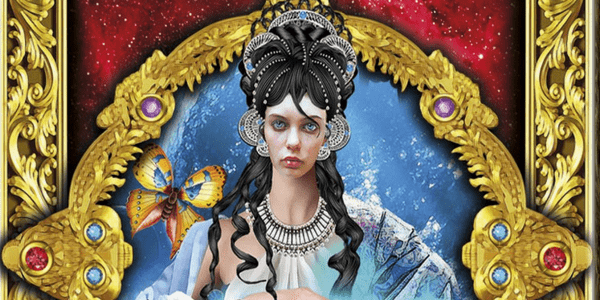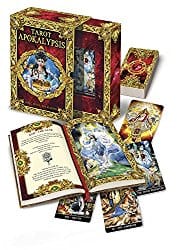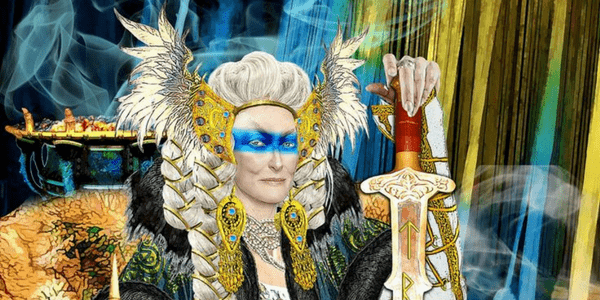
 Tarot Apokalypsis, by Kim Huggens and Erik C. Dunne
Tarot Apokalypsis, by Kim Huggens and Erik C. Dunne
Llewellyn Worldwide, 978-0738749822, 78 cards, 480 pp., 2016
Tarot Apokalypsis is the sophomore effort of artist Erik C. Dunne and Kim Huggens. It’s described as the sister deck to their award-winning Tarot Illuminati. This project serves to bring more diversity to the cards by combining classic imagery with mythology from around the world.
The deck looks impressive. It comes as a set with fully illustrated, borderless cards and a hardcover, 460 page book that clearly outlines not only meanings of the cards, but also the mystery behind them and the mythology used to create them. For me, this deck has a lot of high points, but it is not a perfect deck.
The goal of this deck is to reveal “the sacred,” and to that end it relies on various religious imagery from a wide variety of cultures. The cards feature depictions from Egyptian, Greek, and Roman beliefs as well as Buddhism, Christianity, Judaism, and a host of Indigenous religions in the major arcana.
With the inclusion of these varied traditions, this deck has a ton of diversity. The deities and people depicted in the cards come from a wide variety of backgrounds, allowing it to be truly representative of the world, which is a very refreshing take. Since the deck is so global, the diversity doesn’t seem forced or like a token effort.
The minor arcana is similarly diverse, but it is set up in a completely different manner. Each suit focuses on a different tradition. Wands are Egyptian, swords are Norse, cups are Greco-Roman, and pentacles are Hindu. All of the minor arcana is fully illustrated.
An interesting thing about the minors is that — excluding the court cards — laid out in order, each suit forms its own narrative, much like the Fool’s Journey in the major arcana. This makes readings interesting when you have multiple cards appearing from the same suit, as it adds another dimension to how they may be viewed and interpreted.

The art on the cards is digitally created and pushes the aesthetic of the first deck, Tarot Illuminati, even further. The art of the Illuminati deck merges figures into illustrations, giving the whole card a dreamlike feel. Apokalypsis is very bold and bright. The cards lack a sort of finished quality to them and I found the effect jarring during my readings; however, this is a personal take on the art. I would suggest viewing a few cards online to determine for yourself if the deck is to your taste, as the cover card, an extra card titled “The All Gifted” is not really representative of the deck as a whole. In fact, as an aside, the style of the extra card can be taken as a visual representation of the gap between the first deck and this one as, stylistically, it takes elements from both.
Of concern to all readers is that these cards are all densely illustrated and include a lot of elements. Some are very large, such as the owl and roses featured on the Death card, but there are also tons of smaller background details like the marigolds, the building behind Death, and even the hourglass at her side, that get lost. Although the illustrations can provide great deal of information, it is also very easy to get overwhelmed and miss key details.
As mentioned before, the book that comes with this deck is long and extremely detailed. It is in full-colour and hardbound. It looks opulent with gold borders and a rich, red cover. However, the pages aren’t very well attached and I worried that someone who uses the book regularly would see it fall to pieces.
The text was written clearly with a novice in mind. It spends a good deal of time with foundation information about tarot and its history, even before discussing specific cards. It dives straight into various ways to read and interpret the cards and how to draw connections between them. To help you get started with the deck, it also includes five different spreads to work with a variety of question types.
The bulk of the text, however, are the cards’ descriptions. This is easily 75 per cent of the book or more, and it’s clear to see why. Each card is given a two or three-page explanation that goes over the details of the artwork and the historical relevance of the chosen figures. After these very long sections, it then provides the keywords for the cards.
One thing I did like about how the text was laid out is that the majors and the court cards are each given a full page illustration so you can really review them and see many of the smaller details. I would have liked it if this was carried out throughout minors as well, but they are only given thumbnail illustrations.
The major downside of this text is that the way it’s organized makes it maddening to use. There is a table of contents, but the card sections lack major title pages so there’s no visual indicator that you’re passing into another section.
I did a few sample readings with this deck and found it is not well suited for intuitive reading, as it relies heavily on the mythology as presented by Huggens in the text. In my own readings, I found that reading intuitively didn’t give me the depth that usually comes with that style. When I cracked the book open, the connections between cards became much clearer. Understanding these cards relies very heavily on reading this massive volume.
Because this deck does rely so heavily on the use of the book itself, I don’t think that I would recommend this for anyone who wants to read for others. I feel like this is more a of meditation deck that doesn’t reveal itself quickly. Which is to say, if you were to do a reading on Monday, you may not fully understand it until Friday. This is not a deck that readily lends itself the type of readings that most people do for clients.
Some minor issues with this deck are that although the packaging is lovely and it looks magical on the desk, once you open it, the cards don’t fit flush into the box and there is no bag provided for them. They will slide around which can lead to lost cards. The cards also tend to stick to each other quite a bit so it will take many shuffles before they are ready to read with.
Overall, I think Tarot Apokalypsis is an interesting deck, but I think some of its ability is lost because it’s cramming too much into a single deck of cards. It’s clear, though, that both Dunne and Huggens have great passion for their work and I love the diversity the deck displays.
Although the book is styled to be accessible to readers who are just getting their start, I wouldn’t recommend this as a first, or even second, deck. In order to get the most of this deck, I think that you need to have more familiarity with the cards so you’re not overwhelmed with the sheer amount of information presented.
That being said, Tarot Apokalypsis offers a unique way to look at tarot, and given the time and dedication to study the arcana presented on the cards, it could become a strong tool for self-discovery and meditation.








